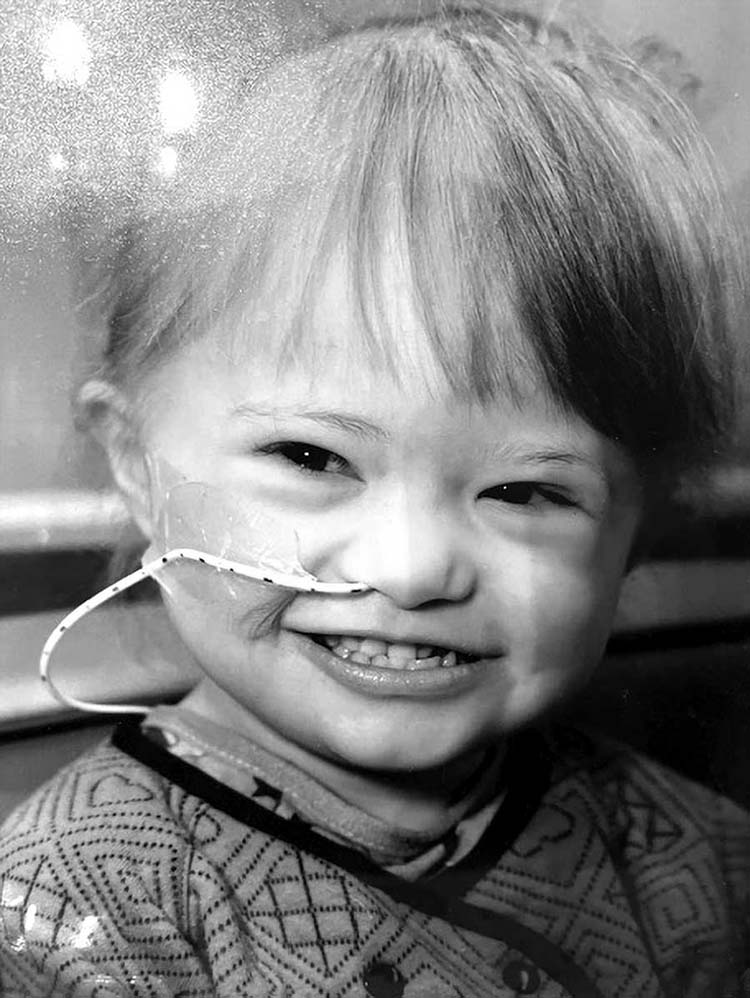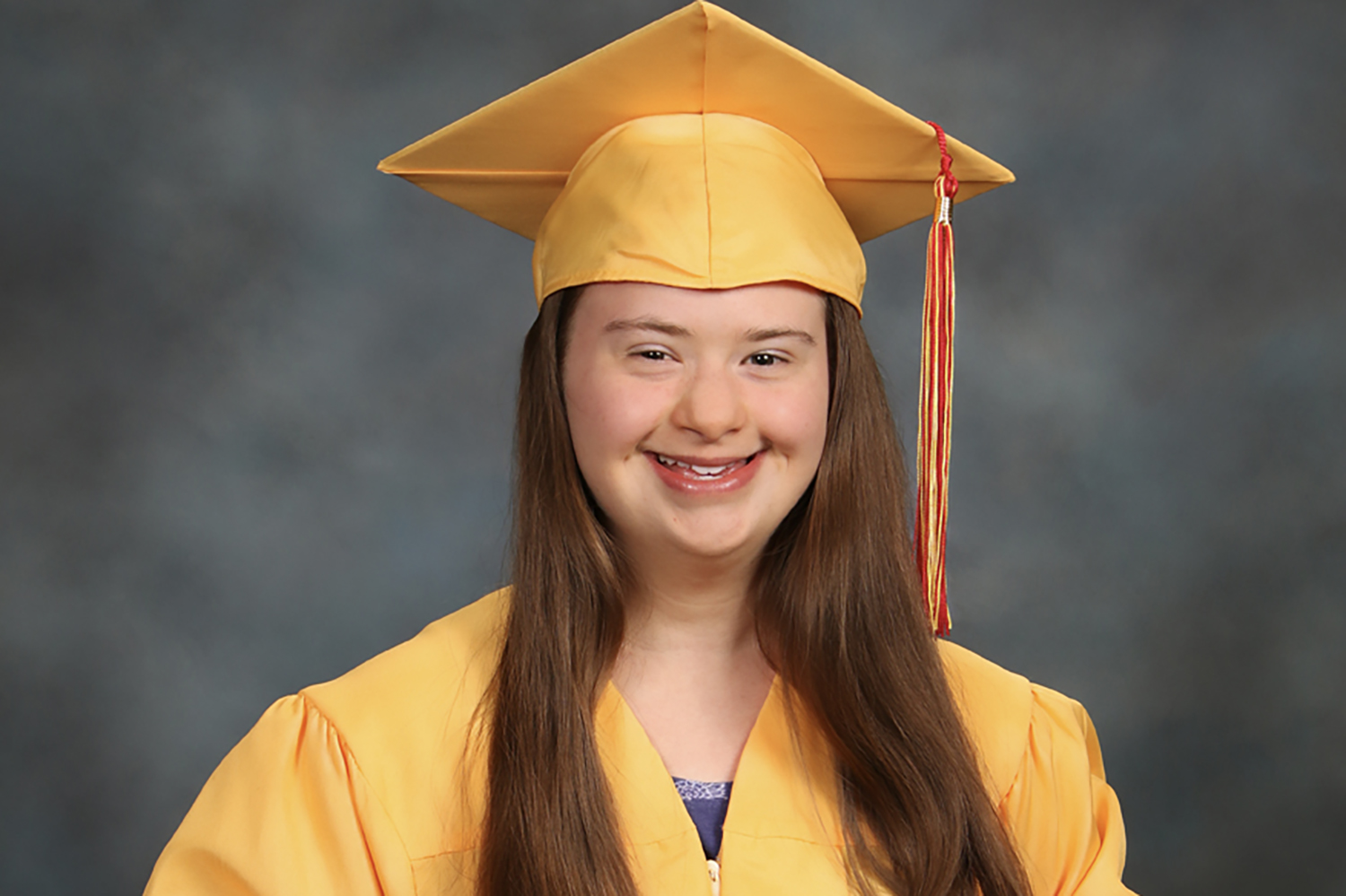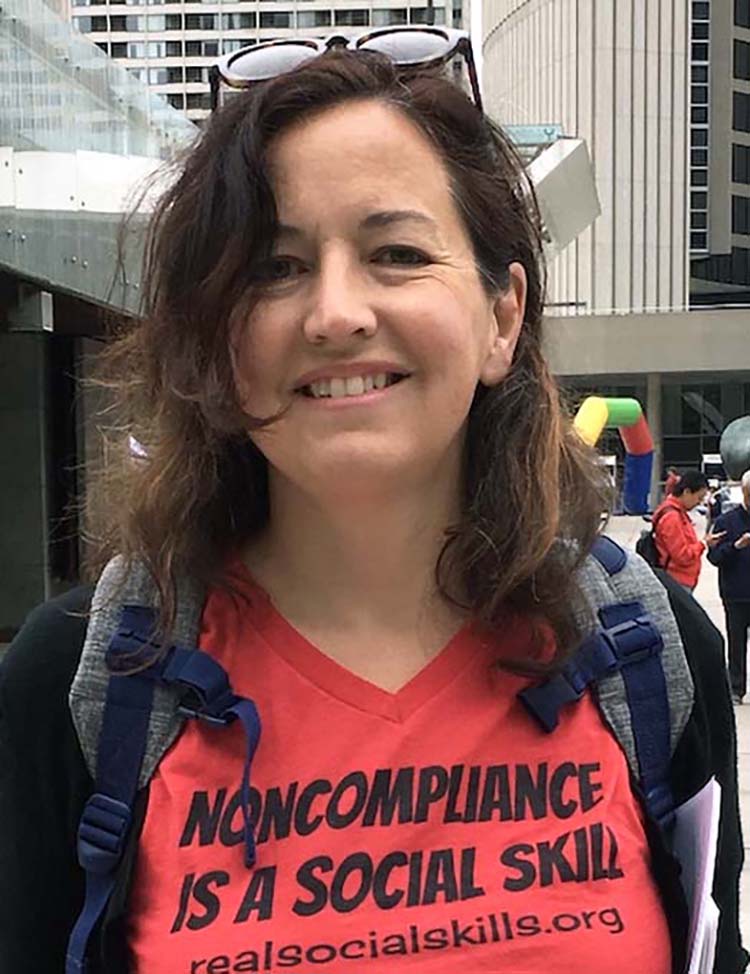KATHRYN FORSYTH LISTS watching YouTube videos, playing sports and working on art projects among her favorite activities, but top of her list is dancing. The 21-year-old from Wynnewood, Pennsylvania, has been taking dance classes since age 3. “I like to show my passion,” Kathryn says.
For nearly as long as she’s been a dancer, Kathryn has also been a cancer survivor. In November 2007, at age 4, she was diagnosed with acute lymphoblastic leukemia (ALL). She immediately began intense chemotherapy at Children’s Hospital of Philadelphia (CHOP), followed by maintenance chemotherapy.
Kathryn’s mother, Lynne, says the diagnosis was a shock, even though she was aware children with Down syndrome like Kathryn have an increased risk of developing leukemia. She and her husband found themselves splitting time between Kathryn’s medical appointments and raising their other daughter, Elisabeth, who is about a year older than her sister. In March 2010, Kathryn completed treatment and has had no signs of cancer since.

Kathryn Forsyth is pictured at age 4 in 2008 while at Children’s Hospital of Philadelphia to receive chemotherapy for acute lymphoblastic leukemia. Photo courtesy of the Forsyth family
Lynne says the staff at CHOP carefully factored her daughter’s Down syndrome into her cancer treatment. After a chemotherapy infusion, Kathryn had a seizure—a side effect that may occur more often in children with Down syndrome after receiving cancer treatment than in pediatric patients without Down syndrome. Her doctors collaborated with pediatric hematology specialists to figure out why she was experiencing these toxic effects.
“They were very cognizant they might need to do things a little differently,” Lynne says of the CHOP staff, noting that awareness wasn’t the norm at the time of Kathryn’s cancer diagnosis. Until the past decade, few studies focused on the barriers faced by people living with intellectual or developmental disabilities (IDD) and cancer as they seek care.
Kathryn is among the estimated 7.4 million Americans with IDD. This population often faces difficulty navigating a health care system not designed to accommodate their needs, leading to worse outcomes for people with IDD diagnosed with cancer. Advocates for people with IDD are calling for health care systems to adapt their services and treatments so all patients can access appropriate care.
Cancer Risk in People With IDD
Although definitions vary, the umbrella term IDD describes when a person has a disorder, usually present from birth, that hinders their emotional, intellectual or physical development, according to the National Institutes of Health. These conditions include autism spectrum disorder, cerebral palsy and Down syndrome. Each type of IDD has different implications for a person’s health, including their cancer risk. In general, children with IDD have a similar risk of developing cancer as most children, but they have a higher risk for certain cancers.
Children with Down syndrome have a 10- to 20-times higher risk of developing ALL and a roughly 150-times higher risk for acute myeloid leukemia than children without Down syndrome. About 2% of children with Down syndrome develop these blood cancers, according to Karen Rabin, a pediatric hematologist-oncologist and director of the leukemia program at Texas Children’s Cancer and Hematology Center in Houston. Although researchers are still investigating the reasons for this higher risk, people with Down syndrome have an extra copy of chromosome 21, and some genes found on this chromosome have been linked to increased leukemia risk. Conversely, people with Down syndrome have a lower risk than the general public for developing most solid tumor cancers.

Kathryn Forsyth graduated from Haverford High School in Haverford, Pennsylvania, in June 2023. Photo courtesy of the Forsyth family
Other people with IDD also face an increased risk for cancer. A study published July 2022 in Annals of Oncology found autistic people 30 or younger with both birth defects and intellectual disability had a nearly five-times higher risk of developing cancer compared with similarly aged individuals without autism. Another study found 138 genes relevant for autism are associated with cancer development.
Due to motor impairment that limits physical activity, children with cerebral palsy have higher rates of obesity, which is associated with higher cancer risk. A study published October 2022 in Preventive Medicine Reports found just 0.5% of children with cerebral palsy developed metastatic cancer, but that rate was nearly 10 times higher than that of children without cerebral palsy.
Barriers to Screening
People with IDD have a high prevalence of late cancer diagnosis. A study published March 2024 in Cancer found patients with IDD were 60% and 44% more likely to have stage IV breast and colorectal cancer, respectively, at diagnosis compared with those without IDD. “For both breast and colorectal cancer, adults with intellectual or developmental disabilities were significantly more likely to be diagnosed at a point in the cancer progression where there were no opportunities for cure,” says Alyson Mahar, the study’s lead author and an epidemiologist and health services researcher at Sinclair Cancer Research Institute in Kingston, Ontario.
Mahar co-authored another study published February 2024 in the Canadian Journal of Public Health that found people with IDD had worse five-year overall survival rates for breast, colorectal and lung cancers compared with those without IDD. Cancer is a leading cause of death among people with IDD, Mahar notes. “For many of those people, it could be preventable, so we’re talking about preventable suffering,” she says.
Common developmental disabilities and how they can impact a person’s life.
A developmental disability is a lifelong condition that is physical, intellectual or both. Among the most common is intellectual disability, which is defined by significant limitations in a person’s ability to learn and solve problems and to pick up life and social skills. Intellectual or developmental disabilities (IDD) can be caused by genetic conditions, complications during pregnancy or birth, or exposure to a disease or toxic substance.
Some of the most common IDD are:
Autism Spectrum Disorder: This neurological and developmental disorder impacts how a person acts, communicates and learns. Often described as neurodivergent, autistic people have difficulty interacting with others, restricted interests and repetitive behaviors. An estimated 1 in 36 8-year-olds is diagnosed with autism. About 38% of autistic children have co-occurring intellectual disabilities.
Cerebral Palsy: This disorder affects a person’s ability to control their muscles due to abnormal brain development or childhood brain damage. People with cerebral palsy, the most common childhood motor disability, have problems with movement and posture and may have related intellectual disabilities.
Down Syndrome: Each cell in the body typically has 23 pairs of chromosomes, but people with Down syndrome have an extra copy of chromosome 21. This impacts brain and body development, causing intellectual disability, small stature and upward slanting of the eyelids. Approximately 1 in 775 babies born in the U.S. is diagnosed with Down syndrome, making it the most common genetic cause of intellectual disability.
These late diagnoses and worse outcomes are in large part due to barriers that prevent people with IDD from undergoing appropriate cancer screening. People with IDD are less likely to access health care in general, often due to lower socioeconomic status, limited transportation options, a lack of doctors used to working with this population, or prior traumatic interactions with the health care system.
When Anne Borden King noticed dimpling on one of her breasts in early 2020, she initially thought it was nothing to worry about. When it hadn’t gone away months later, Borden King, an American writer with autism who advocates for people with the condition from her home in Toronto, sent a photo to her primary care provider, who suspected it was cancer. Following surgery, she was diagnosed with stage II breast cancer that had already spread to both breasts and her lymph nodes.
During her medical appointments, Borden King faced difficulties communicating with doctors—something common among autistic people like herself. She has auditory processing issues, so she often did not understand when health care providers described her treatment, and she never received the information in writing, leading to stress and trauma. “Because I’m autistic, I really like to know what’s coming, what to expect, and I wasn’t told what to expect,” she says.

Anne Borden King, who was diagnosed with stage II breast cancer in 2020, pushes for health care systems to better serve autistic patients. Photo courtesy of Anne Borden King
While Borden King is able to speak, some people with IDD are nonspeaking or speak minimally, so many rely on electronic devices, such as tablets, to help express themselves. Time constraints on office consultations may not allow those with IDD to fully communicate their thoughts or comprehend what the doctor is saying. Additionally, autistic individuals can struggle with interoception, which is a person’s ability to know the status of their body, so they may be unaware of their own symptoms. “It’s very hard to communicate accurately, even if you’re completely typical, so if you’re neurodivergent, there’s an extra barrier there,” says Wendy Ross, a developmental pediatrician and director of the Center for Autism and Neurodiversity at Jefferson Health in Philadelphia.
These difficulties are compounded by the typical medical setting. Neurodivergent people may be oversensitive to sights, smells, sounds and textures, so the bright lights and loud noises of a doctor’s office or hospital can be overstimulating and exacerbate anxiety. Also, some people with IDD have mobility limitations, and the physical equipment used for cancer screening frequently cannot accommodate them. For example, mammography equipment is often not accessible for people who use wheelchairs.
Doctors themselves can be a further barrier due to conscious or unconscious biases against those with IDD. “Across our health care system, the lives of people with disabilities are valued as less than, unfortunately,” says Darcy Milburn, director of Social Security and health care policy for The Arc, a national nonprofit that serves people with IDD. “It can lead to providers just assuming that the life that someone with a disability has is just not worth the additional care.”
Even when providers want to offer quality care for these patients, most lack knowledge of how to do so. In a 2023 survey of oncologists and oncology nurse practitioners, 93.9% reported they received five or fewer hours of training on how to work with people with IDD. “There were multiple areas where they felt like they did not have a handle on how to care for this population,” says Ross, who co-authored the study.
Organizations and websites with information and support for people with intellectual or developmental disabilities.
Most resources for people with cancer don’t offer information tailored to those with intellectual or developmental disabilities (IDD). “There is often a dearth of social resources for people with IDD and their families going through cancer treatment,” says Darcy Milburn, director of Social Security and health care policy for The Arc, a nonprofit that serves people with IDD. “It can be isolating because it is a different experience than a patient without IDD going through cancer treatment.”
The following are some of the organizations that support people with IDD and can help connect them with local health resources:
The Arc: This national nonprofit that advocates for people with IDD has 700 state and local chapters, while its website offers a resource directory and a virtual programs library.
The Autism Society: Through a nationwide network of affiliates, this organization connects autistic individuals with resources and runs a helpline operated by trained specialists.
Cerebral Palsy Guide: This online resource for people with cerebral palsy and their families provides educational materials, along with emotional and financial support.
The Global Down Syndrome Foundation: This nonprofit focuses on enhancing the lives of people with Down syndrome and offers health care information specific to this population.
All these factors combine to prevent people with IDD from receiving cancer screening. In a Danish study published January 2023 in JAMA Network Open, researchers found only 25% of women with IDD received guideline-appropriate breast cancer screening, compared with 62% of women without IDD. “This population has been historically marginalized and systematically underserved in our health care system,” Milburn says.
Cancer Treatment and Survivorship
Once people with IDD begin cancer treatment, they can be more likely to experience harsh side effects. As part of her treatment, Borden King received chemotherapy. Due to her sensitivity differences, she had heightened senses of taste, smell and hearing after starting chemotherapy. “It’s just an exaggerated version of what any patient could feel,” she says. The side effects became unbearable, and in August 2020, she had to stop chemotherapy halfway through the planned treatment course.
For patients with Down syndrome, cancer treatment side effects can sometimes be fatal. In pediatric ALL, standard therapy is approximately 2.5 years of chemotherapy, but children with Down syndrome receiving chemotherapy for ALL have a 12-times higher risk for death from infection, plus elevated rates of increased blood sugar, mouth sores and seizures, compared with children without Down syndrome, according to Rabin. Oncologists now modify treatment for this population, including reducing chemotherapy doses, prescribing additional antibiotics or antifungals to prevent infections, and keeping patients in the hospital for monitoring.
Despite these adjustments, treatment continues to cause more deaths among children with Down syndrome than children without Down syndrome. In a study published Jan. 10, 2024, in the Journal of Clinical Oncology, researchers analyzed data from four clinical trials that included children with ALL. The five-year overall survival for patients with Down syndrome in the trials was 86.8% compared with 93.6% for children without Down syndrome. The difference was in large part due to higher treatment-related deaths among those with Down syndrome, according to Rabin, an author of the study.
People with Down syndrome have a lower risk for some cancers, which may be a result of genetic changes.
While they have a higher risk for pediatric acute leukemias than the general public, people with Down syndrome have a decreased risk for most solid malignancies, such as breast and colorectal cancers. This population may be less likely to smoke or to engage in sexual activity, reducing their cancer risk. Additionally, cancer is typically a disease of old age, with 66 being the median age at diagnosis in the U.S. The average life expectancy for someone with Down syndrome is now 60, but as recently as 1983, it was just 25.
However, behavior and age don’t fully explain the lower rates of solid cancers, according to Joaquin Espinosa, a professor of pharmacology who directs the Linda Crnic Institute for Down Syndrome and the Functional Genomics Facility at the University of Colorado Cancer Center in Aurora. “There’s strong agreement that there’s a genetic basis for this protection,” Espinosa says. Genes on chromosome 21 may have tumor-suppressive functions, making this an intriguing area for cancer research, he says. He also notes people with Down syndrome have a hyperactive immune system, which likely promotes tumor surveillance, and they have lower levels of a growth factor called IGF1, which contributes to their small stature but also could prevent cancer cell growth.
While research increasingly focuses on the long-term effects of cancer treatment, the late effects of treatment have largely remained unexplored in cancer survivors with Down syndrome. “Kids with Down syndrome have really been systematically excluded from studies of the neurocognitive impact of therapy and generally from most studies of late effects,” Rabin says.
Kathryn Forsyth has had her share of health problems—although it’s unclear if her cancer treatment is to blame. In November 2016, she developed sepsis, a life-threatening reaction to an infection, and doctors diagnosed her with an immune deficiency. And nearly 15 years after her first seizure during chemotherapy, Kathryn developed a seizure disorder and began taking medication for it in September 2022.
Making Progress
In 2017, before her breast cancer diagnosis, Borden King co-founded the group Autistics for Autistics Ontario, which advocates for autistic people and educates the public about neurodiversity. As part of the organization’s Autistic Health Access Project, Borden King and others visit medical schools and teach future doctors about how to work with autistic patients. They inform students about how longer appointments, information presented in writing, and personalized and trauma-informed care, among other accommodations, can support this population. “Every accommodation that can help an autistic patient is actually good for every patient,” Borden King says.
Jake McHugh, who was autistic, died from peripheral T-cell lymphoma at age 14 in 2018. His parents keep his memory alive through Jake’s Dragon Foundation, a nonprofit that supports pediatric cancer research and assists families as their children receive treatment.
Some institutions have taken steps to eliminate barriers. For example, the Honickman Center, a Jefferson Health facility that opened in March 2024 to offer specialty services, including cancer care, factors in accommodations for neurodivergent individuals, according to Ross. Semi-enclosed alcoves with appropriate seating and lighting help prevent sensory overload. Neurodivergent patients also receive a bag with headphones, sunglasses and fidget toys upon arrival. The center is also piloting a program where patients and their families note their care preferences before the first appointment so providers can make necessary adjustments. Additionally, oncologists consult with Jefferson’s Center for Autism and Neurodiversity to learn how to provide the best care.
Meanwhile, Dana-Farber Cancer Institute in Boston launched its Neuro-inclusive Oncology Care and Empowerment Program in March 2024. If people share that they have IDD during the patient intake, staff members, who are trained in neuro-inclusive practices, can flag the person’s medical record. Patients undergo an initial assessment so providers can know how they process information and deal with their sensory environment. Social workers, in collaboration with oncologists, create individualized patient materials that visually outline the care they will receive to help prevent distress. “There is a lot of proactive care that we can do; when it becomes reactive, it can be problematic,” says Melissa Levin, a clinical social worker at Dana-Farber who helped develop the program.
Advocates hope legislation can help improve care across the board. In May 2024, the U.S. Department of Health and Human Services updated Section 504 of the Rehabilitation Act, a 1973 law that prohibits discrimination based on disability in federal agencies and federally funded programs. The revisions strengthen protections for people with disabilities and require accessible medical equipment and technology in health care settings, according to Milburn. Additionally, the Healthcare Extension and Accessibility for Developmentally Disabled and Underserved Population (HEADs UP) Act, which has been awaiting congressional approval for years, would designate people with IDD as a medically underserved population. This designation would unlock federal dollars to train doctors to work with these patients and increase reimbursement for providing these services.
The medically underserved designation also could spark more cancer research involving people with IDD. In the past five years, an increasing number of studies have focused on cancer patients with IDD, but it’s not nearly enough, according to Mahar. “We’re trying to generate the evidence necessary to help inspire the health care system to change and to better support people with intellectual or developmental disabilities and cancer and their families,” she says.
Moving forward, experts say, people with IDD must play an active role in both developing research and planning health care services. Mahar notes individuals with IDD have acted as advisers on her research, while Levin and Ross say people with IDD provided crucial input when creating their respective institutions’ programs. “They really are the experts in their lives, and we can collaborate together on the best care,” Levin says.
Cancer Today magazine is free to cancer patients, survivors and caregivers who live in the U.S. Subscribe here to receive four issues per year.





